Viktoria Heimann
Improving Spherical Image Resampling through Viewport-Adaptivity
Jun 23, 2023Abstract:The conversion between different spherical image and video projection formats requires highly accurate resampling techniques in order to minimize the inevitable loss of information. Suitable resampling algorithms such as nearest neighbor, linear or cubic resampling are readily available. However, no generally applicable resampling technique exploits the special properties of spherical images so far. Thus, we propose a novel viewport-adaptive resampling (VAR) technique that takes the spherical characteristics of the underlying resampling problem into account. VAR can be applied to any mesh-to-mesh capable resampling algorithm and shows significant gains across all tested techniques. In combination with frequency-selective resampling, VAR outperforms conventional cubic resampling by more than 2 dB in terms of WS-PSNR. A visual inspection and the evaluation of further metrics such as PSNR and SSIM support the positive results.
Joint Geometry and Attribute Upsampling of Point Clouds Using Frequency-Selective Models with Overlapped Support
Jan 27, 2023Abstract:With the increasing demand of capturing our environment in three-dimensions for AR/ VR applications and autonomous driving among others, the importance of high-resolution point clouds rises. As the capturing process is a complex task, point cloud upsampling is often desired. We propose Frequency-Selective Upsampling (FSU), an upsampling scheme that upsamples geometry and attribute information of point clouds jointly in a sequential manner with overlapped support areas. The point cloud is partitioned into blocks with overlapping support area first. Then, a continuous frequency model is generated that estimates the point cloud's surface locally. The model is sampled at new positions for upsampling. In a subsequent step, another frequency model is created that models the attribute signal. Here, knowledge from the geometry upsampling is exploited for a simplified projection of the points in two dimensions. The attribute model is evaluated for the upsampled geometry positions. In our extensive evaluation, we evaluate geometry and attribute upsampling independently and show joint results. The geometry results show best performances for our proposed FSU in terms of point-to-plane error and plane-to-plane angular similarity. Moreover, FSU outperforms other color upsampling schemes by 1.9 dB in terms of color PSNR. In addition, the visual appearance of the point clouds clearly increases with FSU.
Jointly Resampling and Reconstructing Corrupted Images for Image Classification
Oct 31, 2022Abstract:Neural networks became the standard technique for image classification throughout the last years. They are extracting image features from a large number of images in a training phase. In a following test phase, the network is applied to the problem it was trained for and its performance is measured. In this paper, we focus on image classification. The amount of visual data that is interpreted by neural networks grows with the increasing usage of neural networks. Mostly, the visual data is transmitted from the application side to a central server where the interpretation is conducted. If the transmission is disturbed, losses occur in the transmitted images. These losses have to be reconstructed using postprocessing. In this paper, we incorporate the widely applied bilinear and bicubic interpolation and the high-quality reconstruction Frequency-Selective Reconstruction (FSR) for the reconstruction of corrupted images. However, we propose to use Frequency-Selective Mesh-to-Grid Resampling (FSMR) for the joint reconstruction and resizing of corrupted images. The performance in terms of classification accuracy of EfficientNetB0, DenseNet121, DenseNet201, ResNet50 and ResNet152 is examined. Results show that the reconstruction with FSMR leads to the highest classification accuracy for most networks. Average improvements of up to 6.7 percentage points are possible for DenseNet121.
Frame Rate Up-Conversion Using Key Point Agnostic Frequency-Selective Mesh-to-Grid Resampling
Oct 19, 2022



Abstract:High frame rates are desired in many fields of application. As in many cases the frame repetition rate of an already captured video has to be increased, frame rate up-conversion (FRUC) is of high interest. We conduct a motion compensated approach. From two neighboring frames, the motion is estimated and the neighboring pixels are shifted along the motion vector into the frame to be reconstructed. For displaying, these irregularly distributed mesh pixels have to be resampled onto regularly spaced grid positions. We use the model-based key point agnostic frequency-selective mesh-to-grid resampling (AFSMR) for this task and show that AFSMR works best for applications that contain irregular meshes with varying densities. AFSMR gains up to 3.2 dB in contrast to the already high performing frequency-selective mesh-to-grid resampling (FSMR). Additionally, AFSMR increases the run time by a factor of 11 relative to FSMR.
Increasing the Accuracy of a Neural Network Using Frequency Selective Mesh-to-Grid Resampling
Sep 28, 2022



Abstract:Neural networks are widely used for almost any task of recognizing image content. Even though much effort has been put into investigating efficient network architectures, optimizers, and training strategies, the influence of image interpolation on the performance of neural networks is not well studied. Furthermore, research has shown that neural networks are often sensitive to minor changes in the input image leading to drastic drops of their performance. Therefore, we propose the use of keypoint agnostic frequency selective mesh-to-grid resampling (FSMR) for the processing of input data for neural networks in this paper. This model-based interpolation method already showed that it is capable of outperforming common interpolation methods in terms of PSNR. Using an extensive experimental evaluation we show that depending on the network architecture and classification task the application of FSMR during training aids the learning process. Furthermore, we show that the usage of FSMR in the application phase is beneficial. The classification accuracy can be increased by up to 4.31 percentage points for ResNet50 and the Oxflower17 dataset.
Frequency-Selective Geometry Upsampling of Point Clouds
May 03, 2022



Abstract:The demand for high-resolution point clouds has increased throughout the last years. However, capturing high-resolution point clouds is expensive and thus, frequently replaced by upsampling of low-resolution data. Most state-of-the-art methods are either restricted to a rastered grid, incorporate normal vectors, or are trained for a single use case. We propose to use the frequency selectivity principle, where a frequency model is estimated locally that approximates the surface of the point cloud. Then, additional points are inserted into the approximated surface. Our novel frequency-selective geometry upsampling shows superior results in terms of subjective as well as objective quality compared to state-of-the-art methods for scaling factors of 2 and 4. On average, our proposed method shows a 4.4 times smaller point-to-point error than the second best state-of-the-art PU-Net for a scale factor of 4.
Frequency-Selective Mesh-to-Mesh Resampling for Color Upsampling of Point Clouds
Mar 17, 2022
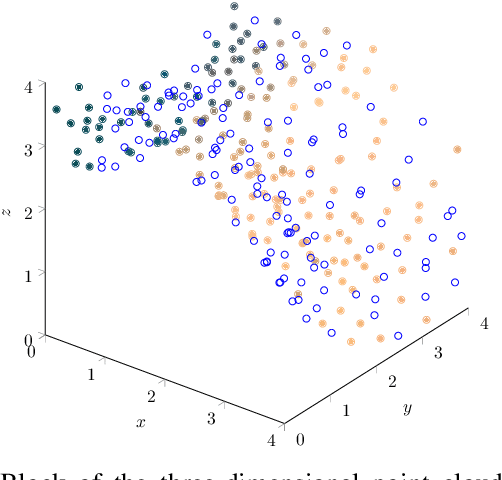
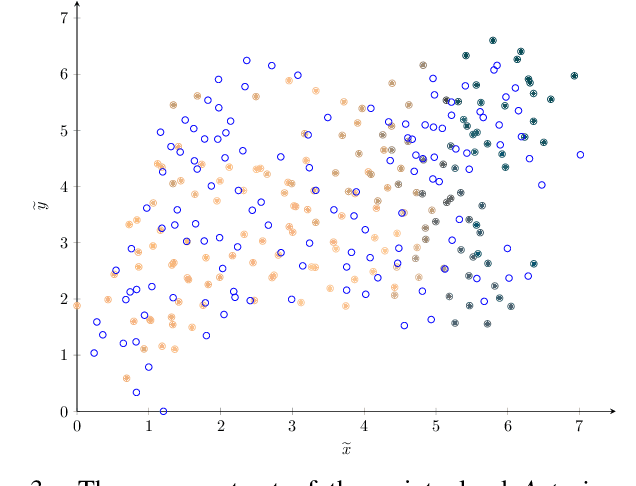
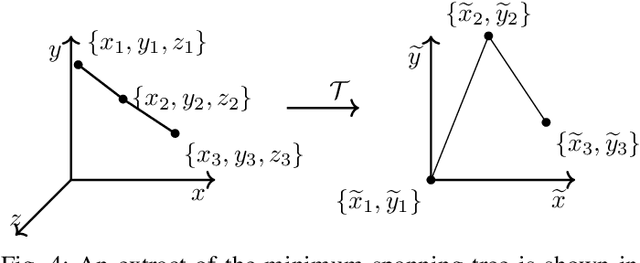
Abstract:With the increased use of virtual and augmented reality applications, the importance of point cloud data rises. High-quality capturing of point clouds is still expensive and thus, the need for point cloud super-resolution or point cloud upsampling techniques emerges. In this paper, we propose an interpolation scheme for color upsampling of three-dimensional color point clouds. As a point cloud represents an object's surface in three-dimensional space, we first conduct a local transform of the surface into a two-dimensional plane. Secondly, we propose to apply a novel Frequency-Selective Mesh-to-Mesh Resampling (FSMMR) technique for the interpolation of the points in 2D. FSMMR generates a model of weighted superpositions of basis functions on scattered points. This model is then evaluated for the final points in order to increase the resolution of the original point cloud. Evaluation shows that our approach outperforms common interpolation schemes. Visual comparisons of the jaguar point cloud underlines the quality of our upsampling results. The high performance of FSMMR holds for various sampling densities of the input point cloud.
* 6 pages, 8 figures, MMSP 2021
Key Point Agnostic Frequency-Selective Mesh-to-Grid Image Resampling using Spectral Weighting
Mar 15, 2022
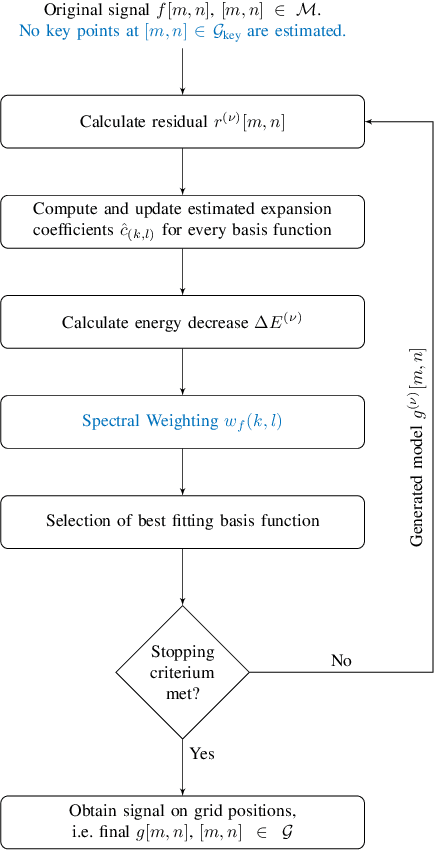

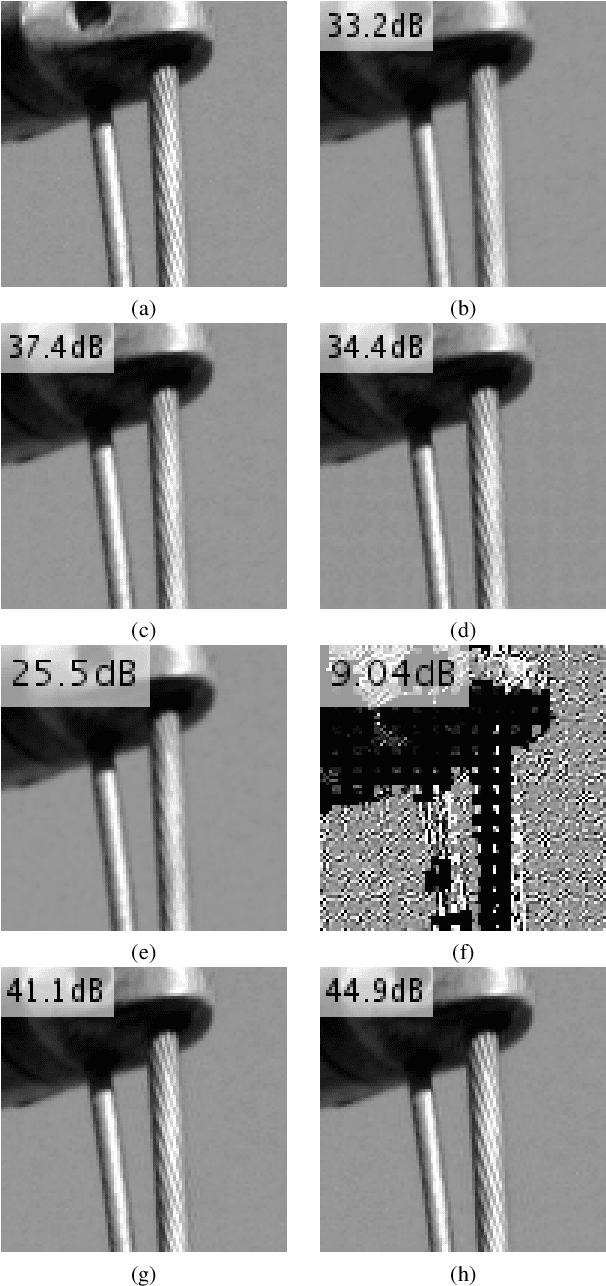
Abstract:Many applications in image processing require resampling of arbitrarily located samples onto regular grid positions. This is important in frame-rate up-conversion, super-resolution, and image warping among others. A state-of-the-art high quality model-based resampling technique is frequency-selective mesh-to-grid resampling which requires pre-estimation of key points. In this paper, we propose a new key point agnostic frequency-selective mesh-to-grid resampling that does not depend on pre-estimated key points. Hence, the number of data points that are included is reduced drastically and the run time decreases significantly. To compensate for the key points, a spectral weighting function is introduced that models the optical transfer function in order to favor low frequencies more than high ones. Thereby, resampling artefacts like ringing are supressed reliably and the resampling quality increases. On average, the new AFSMR is conceptually simpler and gains up to 1.2 dB in terms of PSNR compared to the original mesh-to-grid resampling while being approximately 14.5 times faster.
* 6 pages, 5 figures; Originally submitted to IEEE MMSP 2020
 Add to Chrome
Add to Chrome Add to Firefox
Add to Firefox Add to Edge
Add to Edge